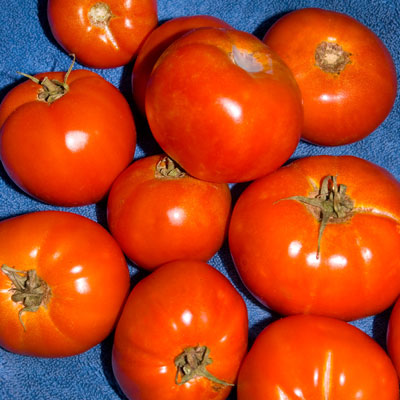Success with Tomatoes
Follow these simple guidelines if you want the best yield ever from your tomato patch. I’ll hit them quickly. Forgive punctuation and incomplete sentences. I’m sending you just the bullets of critical tips.

Young transplants are appearing in nurseries all across Texas. Buy plants that are tough and sturdy. A reddish cast to stems is a good sign.
Tomatoes will need…
• Full sun. Anything less diminishes their yield.
• Raised beds to prevent waterlogged soils. Tomato roots are intolerant of high water tables.
• Well-prepared garden soil, including 5 or 6 inches of a variety of organic matter (peat moss, compost, rotted manure, shredded pine bark mulch, humus, etc.) and 1 inch of expanded shale if amending a clay soil. Rototill to blend to 12 inches deep.
• Proper planting time. You have a narrow window – from the average date of your last killing freeze for your area to three weeks after that date. Tomato plants are intolerant of frost and freezes. Heat is also their enemy as summer approaches.
• Proper varieties. Avoid large-fruiting types such as Big Boy, Beefsteak, and the giant heirlooms. They won’t set fruit when temperatures are below 70 at night or above 90 in day. Stay with small to mid-sized types for maximum productivity. Listed in increasing order of size:
Red Cherry
Yellow Pear
Sweet 100
Porter
Roma
Early Girl
Super Fantastic
Tycoon
Celebrity
• Tall cages to keep plants, fruit off ground. Concrete reinforcing wire cut in 52-inch lengths, then rolled into cylinders work well. secure with 2X2-inch wood stakes, two per pot.

Tomato cages protect both the plants and the fruit. Production is aided greatly. These folding cages were sold in a Texas hardware store.
• Wrap cages with frost cloth for fastest start. Fold excess cloth over top of cage. Open tops on warm days. Cloth also lessens insect invasion. Plants still get ample sunlight for normal growth.
• Fertilize with high-nitrogen food to keep plants vigorous. Monthly if granular. Weekly if liquid.
• Allow all “suckers” (side branches) to develop. Push them back within the cages.

Tomato flowers are pollinated by vibration of wind. In still times, you may have to thump the flower clusters daily.
• If blooms fail to set, you may not be getting enough vibration by wind. Thump the flower clusters with your finger to jar pollen loose.
• Harvest as fruit makes the turn from green toward pink. Allow fruit to ripen on towels or newspaper indoors to protect against sunscald and bird pecking. It will lose no flavor or nutritional value.
• Plant a second crop of fresh plants the last week or June or first week of July (one week earlier in Panhandle, one week later in South Texas). These “fall” tomatoes will grow the balance of the summer, then produce in fall’s cooler weather. Planting that early is critical for maximum yield. Ask your nursery if they will have them in stock. Same varieties as for spring.



